Birds are truly magnificent creatures making them a captivating subject for photography.
However, capturing their beauty in action can be an incredibly challenging task.
Birds are known for their quick movements and their tendency to swiftly change their location.
This requires bird photographers to be patient and observant.
It also helps to have the best camera for the job.
When it comes to bird photography, choosing the right camera is crucial.
Finding the perfect camera for capturing birds in flight can be a tricky business.
You also need to consider a camera good enough to capture at a distance and quiet enough not to startle.
It is also essential to have a high performing auto focus system to track and capture sharp images of their rapid movements.
There are numerous great options on the market that are perfect for bird photography.
However, the perfect one for you depends on your own unique preferences, shooting style and technical requirements.
It’s important to research and test various cameras to find the one that aligns with you.
But this can be both time-consuming and costly.
Thankfully, you’ve come to the right place.
As a professional photographer, I know what makes a camera great.
However, some of these things were either irrelevant or more important when I applied to bird photography.
I found that my favorite, trusty camera sadly missed the mark.
This put me in the search for a new camera, specifically to capture beautiful images of birds.
I tested many cameras and found the best ones for bird photography so that you don’t have to.
Following my research, I found five cameras that I loved for bird photography.
These cameras featured everything important in a camera for bird photography including great auto focus and an excellent lens selection.
Each camera has something that makes it special and more suited to select individuals.
Therefore, you are almost guaranteed to find your perfect camera for bird photography from these reviews.
To help you out further, I have also outlined when to look for when buying a camera for bird photography.
By understanding the features you require, you can make an informed design and invest in the right camera.
You’ll be equipped to capture the stunning beauty of birds in flight, freezing those breathtaking moments in time for everyone to admire.
Best Camera for Bird Photography – Reviews
There are many great cameras on the market for bird photography.
However, after reviewing these five, I found them to be the best cameras for bird photography.
Each one has its own uniqueness making it great for bird photography.
There is no doubt that one of these five cameras will be your perfect fit.
Canon EOS 90D – Best Camera for Bird Photography Overall
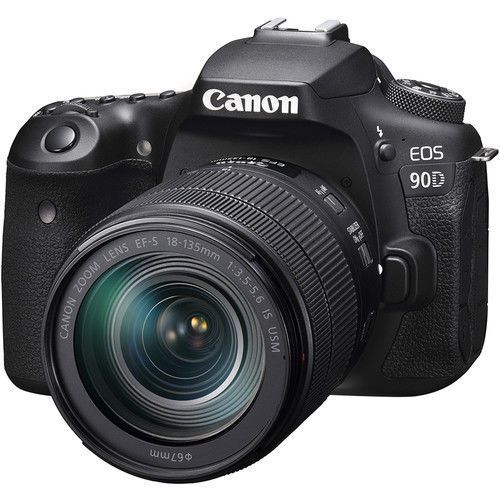
The Canon EOS 90D is a powerhouse camera that is perfect for bird photography
This Canon captures stunning images with the help of its advanced auto focus system and Canon’s excellent range of telephoto lenses.
With 45 auto focus points and Canon’s Dual Pixel AF technology, the camera delivers fast and accurate autofocus, even in challenging lighting conditions.
This makes it ideal for capturing birds in flight or any movement with precision and sharpness.
The Canon EOS 90D is also compatible with Canon’s extensive EF and EF-S lens range.
Whether you need a versatile zoom lens or a high-powered fixed telephoto lens, you can find the perfect match for your bird photography needs.
Whilst a downside may be that this camera does not have in-body image stabilization, you can find this as a feature of many Canon lenses instead.
The flexibility and variety of lens choices allow you to capture birds in flight and capture their natural behavior without disturbing them.
Another standout feature of this camera is its exceptional battery life.
Its great battery life ensures that you can continue shooting for extended periods without worrying about running out of juice.
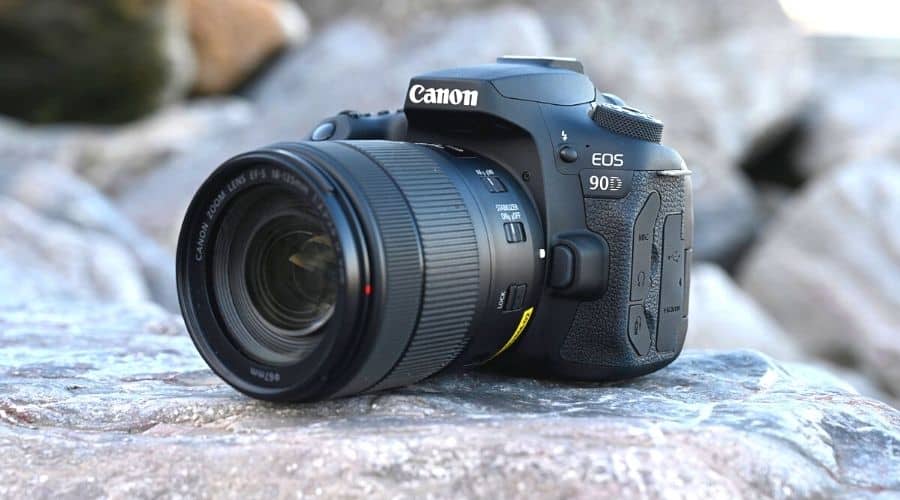
Auto Focus
Features a Dual Pixel auto focus system that works well and has micro adjustment allowing focal points to be adjusted for 40 different lenses. Whilst this camera was slower to focus than other cameras, the accuracy resulted in phenomenal crisp images.
Shutter Speed
The shutter speed on the Canon EOS 90 is pretty great with a maximum speed of 1/16,000 sec. This allows you to quickly capture the image you want without missing the moment.
Burst Mode
Offers both high-speed and low-speed continuous shooting with high-speed capturing 10 fps when using the viewfinder or 11 fps when shooting in Live View mode. Whilst the burst mode itself is decent, saving images captured through burst mode is time-consuming. I found it could take up to a minute to save images and I occasionally missed another shot because of this.
Low Light Performance
With a 32.5MP sensor, low light performance is great. You will see this camera has an excellent low light performance with a maximum ISO of 25,600. You’ll notice very little noise in images up to an ISO of 3200.
Lenses
Canon lenses are renowned for their great performance and high quality results. There are a wide variety of fixed telephoto lenses available alongside excellent zoom lenses. The EF 70-300mm is a popular choice for nature photographers allowing you to capture at varying distances without the need to swap out lenses.
Image Stabilization
The camera does not have in-body image stabilization but is compatible with Canon’s range of lenses that feature image stabilization. This is therefore not an issue.
Battery Life
Battery life is great. You can shoot almost 3.4k photos in 10fps.
The Canon EOS 90D is certainly impressive.
With its remarkable battery life, advanced autofocus capabilities and extensive lens options, this camera was the one which stood out over the rest.
There is no doubt that this camera is a reliable companion for bird photographers.
“I loved the performance of this camera and the results it achieved. In my opinion, the Canon EOS 90D was the best camera for bird photography overall.”
Nikon Coolpix P1000 – Best Camera for Bird Photography for Beginners
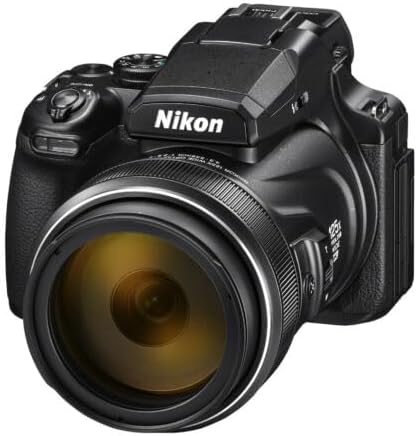
The Nikon Coolpix P1000 is a versatile camera that stands out for its impressive fixed zoom lens.
With an astounding 125x optical zoom range, it allows photographers to capture subjects at incredible distances
This is great for capturing birds whether in flight or still without disturbing them.
The camera’s auto focus is also commendable, quickly and accurately locking onto the subject ensuring sharp and detailed images.
However, the P1000 falls short in terms of battery life which is very limited.
Additionally, its low light performance is average, struggling to deliver optimal image quality in challenging lighting conditions.
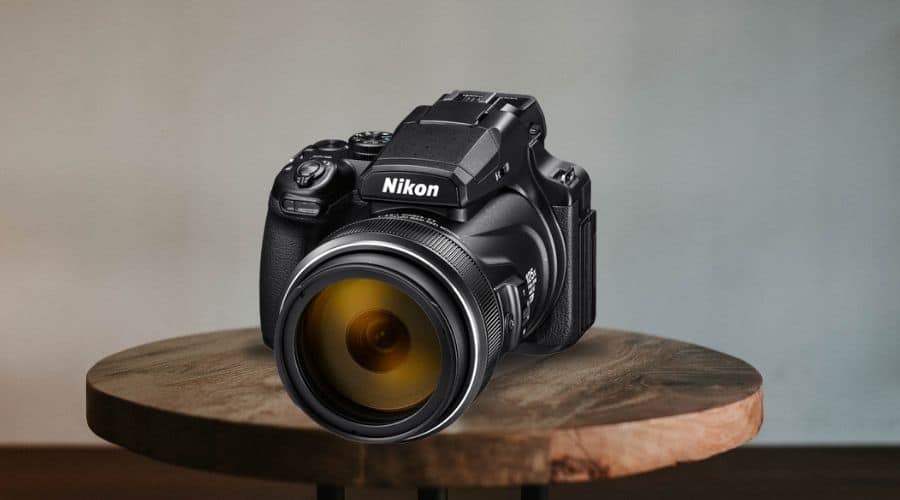
Auto Focus
This camera has great auto focus that doesn’t lag even when at maximum zoom. It performs extremely well and is excellent as a point and shoot for bird photography.
Shutter Speed
Maximum shutter speed of 1/4000 which is decent but not the best. A big let down is that the shutter speed dramatically reduces at high ISO.
Burst Mode
Maximum continuous shooting of 7 fps which is about average.
Low Light Performance
Of all five cameras I tested, the Coolpix P1000 sadly had the poorest low light performance. This is due to its small sensor and is unfortunately the one major downfall of this camera. However, it does have a maximum ISO of 6400 that performs decently with limited image noise.
Lenses
This camera has a fixed lens which limits options. However, it is very efficient when it comes to shooting far objects. It’s all possible with a Tamron 18-400mm lens. The lens on this camera is incredible and it also means that you don’t need to carry heavy interchangeable lenses around.
Image Stabilization
The Coolpix P1000 has great image stabilization. It uses a Dual Detect Optical Vibration Reduction system to stabilize both horizontal and vertical movements. You can rely on this camera for sharp stills and smooth video.
Battery Life
Limited battery life of up to 200 shots per single charge. It also has a separate wall charger. You have to charge the battery in-camera itself with the provided kit charger which makes it inconvenient for switching out batteries.
If you rely heavily on low light performance or a great battery life, this is not the camera for you but for others, it may be a worthy compromise.
While the battery life and low light performance let this camera down, the zoom capabilities and auto focus are remarkable.
“For those seeking an all-in-one camera with extraordinary zoom capabilities for bird photography, the Nikon Coolpix P1000 remains a solid choice.”
Canon EOS 80D – Best Camera for Bird Photography for Focus
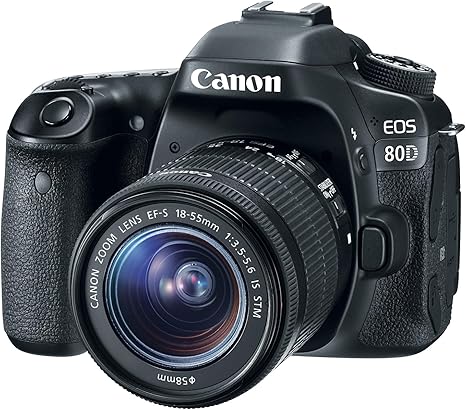
The Canon EOS 80D offers a range of impressive features that make it a reliable choice for bird photographers.
While its low light performance may not be its strongest suit, the camera compensates with a great shutter speed.
This is great for capturing fast-moving subjects like birds in flight with remarkable precision.
The advanced autofocus system ensures quick and accurate focus, further enhancing the chances of capturing sharp and detailed images.
In addition, the EOS 80D benefits from a wide selection of lenses, providing flexibility and options to meet various shooting needs.
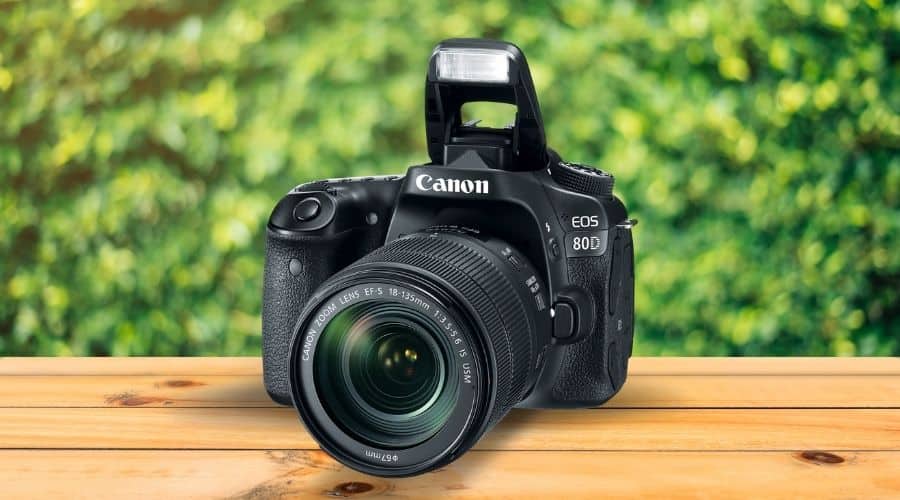
Auto Focus
High performing auto focus that quickly and accurately captures every detail of a subject. With 45 auto focus points, this camera is great for outdoor life photographers.
Shutter Speed
1/8000 maximum shutter speed which is great for capturing the moment precisely when it happens.
Burst Mode
Average burst mode of 7 fps.
Low Light Performance
The low light performance of this camera is less than impressive. Whilst this camera is the size of a full frame, it only has a crop sensor. This drastically limits its low light capabilities. ISO up to 1600 are relatively noise free but quality dramatically reduces above this. However, focus in low light remains good.
Lenses
Compatible with Canon’s EF and EF-S ranges. Canon have a great number of incredible lenses to choose from including the EF 70-300mm which is a great option for bird photography.
Image Stabilization
The EOS 80D does not have in-body image stabilization but many Canon lenses do have this feature.
Battery Life
Decent battery life. It can easily take up to 600 photos on a single charge. Very suitable for full-day use.
Despite its limitations in low light situations, the Canon EOS 80D remains a solid camera choice for those seeking excellent shutter speed, autofocus and lens versatility.
All other aspects of this camera are either average when compared to other cameras or excel.
“Whilst I was really disappointed by the low light performance of the Canon EOS 80D, all other aspects made it a great option for bird photography.”
Sony Cyber‑Shot RX10 IV – Best Camera for Bird Photography for Continuous Shooting

The Sony Cyber-shot RX10 IV is a great camera for bird photography that impresses in several key areas.
Its standout feature is the excellent zoom lens which offers an impressive focal range, making it ideal for capturing distant subjects such as birds.
The camera’s autofocus system is also superb, ensuring quick and accurate focus even on fast-moving subjects.
The shutter speed is about average but the camera makes up for it with an excellent burst mode which is the best of all five cameras.
This is a big downside of this camera as it puts limitations on spontaneous photography.
I found that if the camera was turned off, I couldn’t quickly grab it to snap something sudden.
This is because the initial start up was too long.
Most often, I had missed the shot by the time the camera was ready.
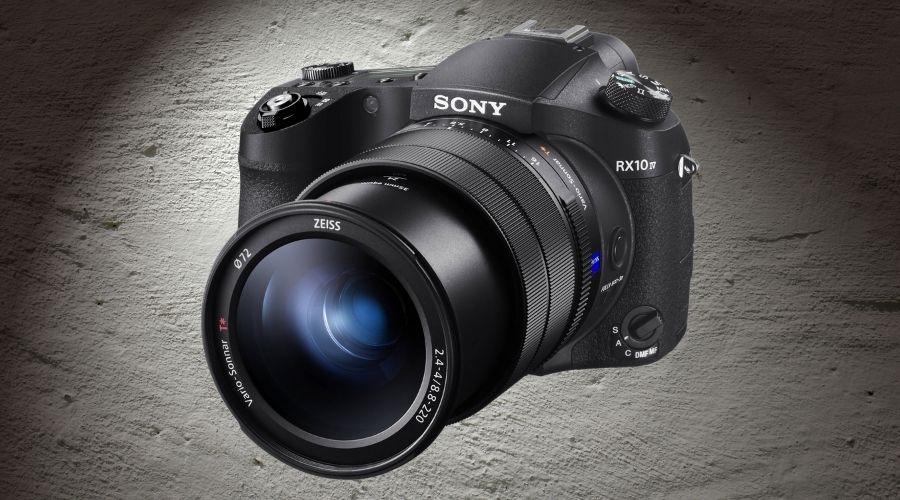
Auto Focus
The auto focus on the CyberShot RX10 IV is simply superb. It focuses quickly and locks accurately with eye tracking that even works on birds.
Shutter Speed
Maximum shutter speed of 1/3200. This is decent but not the best of the five cameras tested.
Burst Mode
Outstanding burst mode that can capture up to 24 fps. If you want maximum opportunity to get the shot, there is no better camera than this one.
Low Light Performance
Has a native ISO of 12,800 than is extendable to 25,600. Great results up to 3200. However, its small sensor size certainly has a slight impact on low light performance but it performs better than most bridge cameras.
Lenses
This camera has a phenomenal fixed zoom lens. The 24-600mm lens has a terrific capability to zoom without adding large and costly lenses. This camera has the same high-powered zoom performance of the best telephoto lenses on the market with the additional cost.
Image Stabilization
Features Sony’s SteadyShot technology which is great for image stabilization.
Battery Life
Battery life is not the worst but definitely below average. You can capture up to 420 shots per single charge. You will want to ensure you have spare batteries with you for a day of shooting.
The RX10 IV is a great choice for those wanting a versatile camera with a fantastic zoom lens and reliable autofocus.
“Whilst its start-up time of the Sony Cyber-shot RX10 IV is poor and low light performance is below average, you can certainly compromise on these elements for the other great features.”
Nikon D5600 – Best Camera for Bird Photography for Low Light Performance
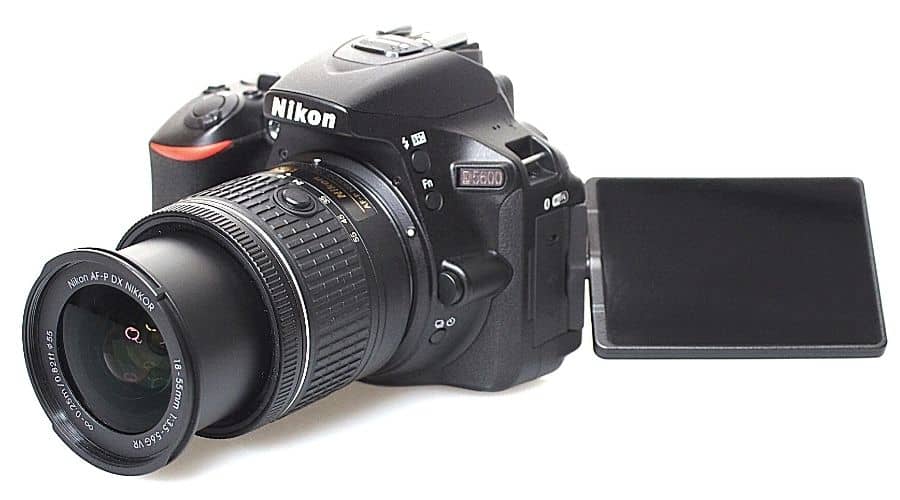
The Nikon D5600 is an extremely reliable camera that excels at bird photography.
While its burst mode might be lacking, the camera compensates with its excellent low light performance, great auto focus and incredible lens options.
With its impressive ISO range and noise reduction capabilities, the D5600 delivers high-quality images even in challenging lighting conditions. Additionally, the camera offers a wide range of lens options allowing you to very specifically choose lenses that suit your specific needs and preferences.
Auto Focus
Great auto focus that works extremely well for stills. However, in video mode, it is terrible and completely unusable.
Shutter Speed
Maximum shutter speed of 1/4000 which is average.
Burst Mode
Sadly, the Nikon D5600 has the poorest performing burst mode of all five cameras at just 5 fps. Whilst this is still decent for capturing multiple shots quickly, it has limitations on the final result compared to the other cameras.
Low Light Performance
Whilst the Nikon D5600 is a crop sensor, this camera has phenomenal low light performance. It has a maximum ISO of 25,600 that produces beautiful images even at high ISO. Plus, the auto focus works well even in extremely low light. Out of all the cameras, this was the one that performed the best in tricky lighting conditions.
Lenses
Incredible selection of compatible lenses from the Nikon and Sigma ranges. Both the Nikon 70-300mm and the Sigma 18-300mm are extremely popular lenses for bird photographers working with Nikon cameras. However, Sigma also have an outstanding 150-600mm that is also worth looking at.
Image Stabilization
This camera does not have in-body image stabilization but is compatible with Nikon’s selection of interchangeable lenses that do feature image stabilization.
Battery Life
Excellent battery life last up to 970 shots per single charge.
In terms of lens options and low light performance, this camera is incredible for bird photography.
It also has a great auto focus and battery life making it a contender for the top spot.
“The only thing that really lets this camera down is its limited burst mode. However, if you are willing to compromise on this, I think the Nikon D5600 is an impressive camera for bird photography.”
How to Choose the Best Camera for Bird Photography
To consider a camera one of the best for bird photography, there are certain features it requires.
If you are in the market for the best camera for bird photography, weigh up the features below before making your decision.
All of these features are crucial for bird photography.
However, some will be more relevant and important to you than others.
In this instance, you can afford to prioritize and compromise in other areas.
Auto Focus
One of the most critical aspects to consider is the camera’s auto focus system.

Particularly if you want to capture birds in flight, you will need a swift and accurate autofocus to keep up with their rapid movements.
This will ensure that you can capture sharp images even during take-off and landing.
Look for a camera that offers advanced autofocus capabilities, specifically a tracking feature.
This will lock you subject into focus and keep them clear even during movement.
A camera with a high number of AF focus points will be very advantageous to your bird photography.
This will give you better ability to track a moving object.
Overall, you are likely to use auto focus predominantly as there is just not the time to manually focus in bird photography.
For this reason, a great auto focus system is one of the most important features of any camera used for bird photography.
Burst Mode
A highly important feature to consider is the camera’s burst mode or continuous shooting rate.
Birds have unpredictable behavior.
Burst mode takes multiple shots in quick succession to increase your chances of capturing that perfect moment.
The higher the burst rate, the more shots the camera will take in a second.
This is essential for capturing birds in flight.
With burst mode, you can rest assured that you are more likely to get the shot you were hoping for.
Shutter Speed
A good shutter speed is of utmost importance in bird photography due to the fast and unpredictable nature of birds in flight.
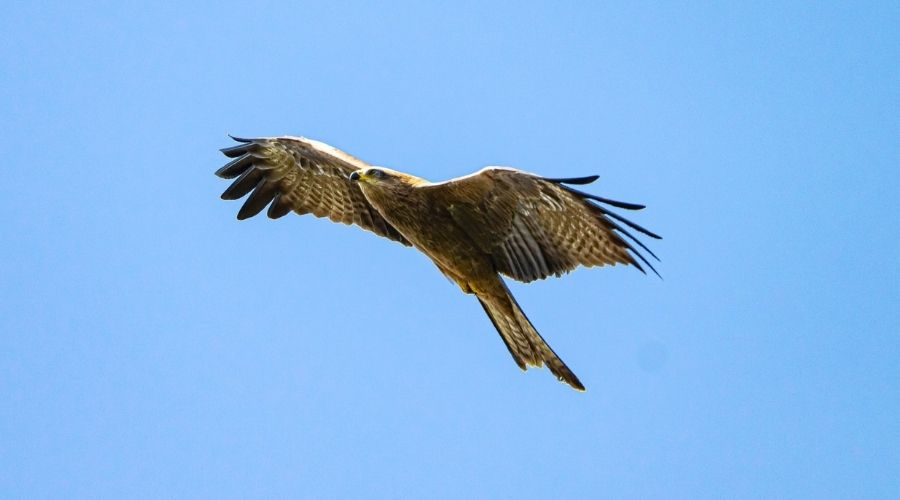
Birds move swiftly, changing direction and speed rapidly making it crucial to freeze their motion effectively.
A fast shutter speed allows photographers to capture the details of the bird and the overall action without any motion blur.
It helps to create sharp, crisp images showcasing the beauty and grace of the birds.
Additionally, a high shutter speed enables photographers to capture the precise moment when a bird flaps its wings or takes off.
This results in dynamic and visually compelling photographs.
Therefore, understanding and utilizing appropriate shutter speeds is essential in bird photography to ensure that the fleeting moments are captured.
Low Light Performance
When capturing in nature, lighting conditions can be highly unpredictable and unreliable.
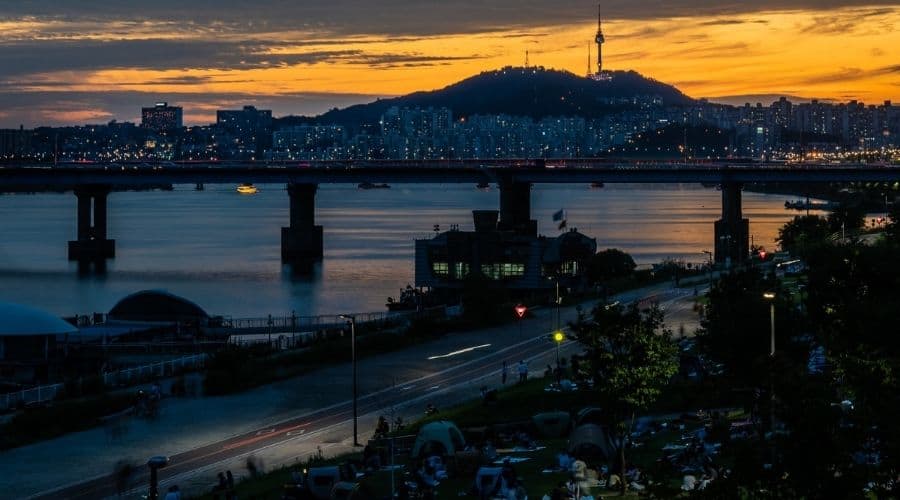
With ever changing weather conditions, great lighting is not guaranteed.
There are many things to consider when it comes to low light performance for bird photography.
The camera’s image sensor plays a vital role in the quality of the images.
Opting for a camera with a larger sensor size allows for better low light performance and higher resolution.
A higher resolution sensor will capture finer details and provide the flexibility to crop images without sacrificing image quality.
In addition, it is essential to have a camera with a good ISO range that performs well.
Birds are often most active during dawn and dusk when lighting conditions are challenging.
A camera with excellent low light capabilities and a wide ISO range will help you capture beautiful images regardless of lighting conditions.
Lenses
When shooting birds, it is almost impossible to capture them at a close distance.
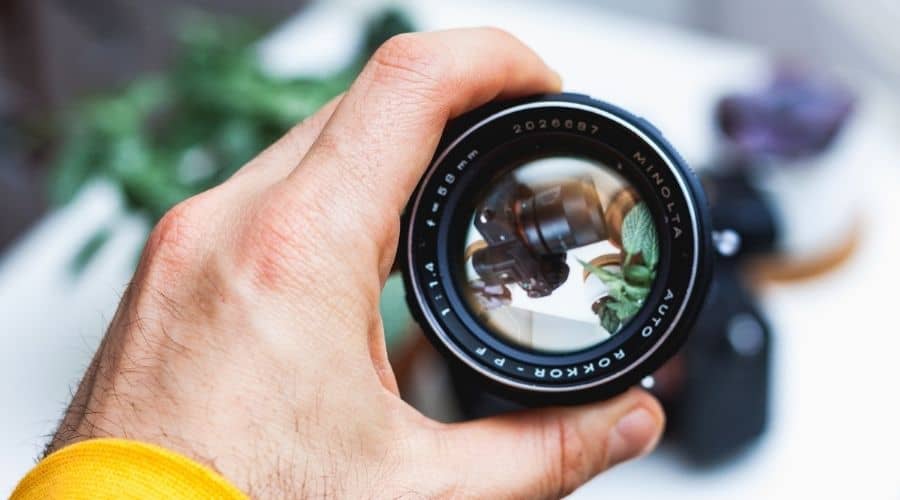
Birds are easily startled and if you were to get too close, you would risk them flying away and losing the shot.
This is why it is very important to have a great lens selection for bird photography.
This allows you to shoot from a distance without compromising on image quality.
Ideally, you want to look for lenses with long focal lengths such as telephoto or super-telephoto lenses.
This allows your camera to get closer shots of birds without disturbing them.
These lenses provide the reach required to capture birds from a distance resulting in stunning close-up shots.
Image Stabilization
As you are likely to be shooting from a distance, image stabilization is particularly important.

When using a telescopic lens, image stabilization ensures your photo is crisp and clear.
It allows you to shoot more spontaneously without needing to rely on a heavy tripod setup.
Image stabilization is also important if you are planning to shoot video of birds.
It helps to produce smooth and fluid videos of movement like birds in flight.
Battery Life
Whilst a decent battery life is always an important feature of any camera, it is of particular importance for bird photography.
As birds are unpredictable, a shoot can take a long time.
It would be highly inconvenient for the battery to drain whilst waiting around trying to capture the perfect shot.
Depending on the camera, burst mode can also use up battery power so having a camera with a good battery life to begin with will last longer even when shooting continuously.
Best Camera for Bird Photography – My Verdict
All five of these cameras achieved stunning results.
I captured beautiful stills (and even some great videos) of birds on each and every one of these options.
However, if I was to identify the real winner, for me, it was the Canon EOS 90D.
There are many reasons why I gave this camera my coveted top spot of best camera for bird photography.
Predominantly, its excellent auto focus and great lens options made it truly standout from the rest.
Plus, it has a great battery life, decent low light performance and excellent shutter speed.
However, that is not to say that this is the camera for you.
If you prioritize exceptional low light performance, the Nikon D5600 is therefore the one for you.
On the other hand, if you want to pretty much guarantee you get the shot every time, the continuous shooting mode on the Sony CyberShot RX10 IV is unrivaled.
But if you’re a total beginner, you may want to stick with the Nikon Coolpix P1000.
This camera is easy to use, has great features and you don’t need to swap out lenses for stunning close ups.
Any of these five cameras will achieve beautiful results in bird photography.
The only question is, which camera is the right one for you?

